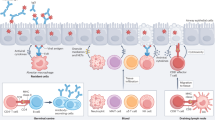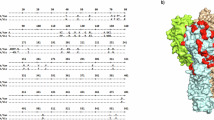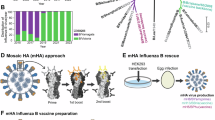Abstract
Highly pathogenic avian influenza viruses pose a continuing global threat. Current vaccines will not protect against newly evolved pandemic viruses. The creation of 'universal' vaccines has been unsuccessful because the immunological mechanisms that promote heterosubtypic immunity are incompletely defined. We found here that rapamycin, an immunosuppressive drug that inhibits the kinase mTOR, promoted cross-strain protection against lethal infection with influenza virus of various subtypes when administered during immunization with influenza virus subtype H3N2. Rapamycin reduced the formation of germinal centers and inhibited class switching in B cells, which yielded a unique repertoire of antibodies that mediated heterosubtypic protection. Our data established a requirement for the mTORC1 complex in B cell class switching and demonstrated that rapamycin skewed the antibody response away from high-affinity variant epitopes and targeted more conserved elements of hemagglutinin. Our findings have implications for the design of a vaccine against influenza virus.
This is a preview of subscription content, access via your institution
Access options
Subscribe to this journal
Receive 12 print issues and online access
$259.00 per year
only $21.58 per issue
Buy this article
- Purchase on SpringerLink
- Instant access to full article PDF
Prices may be subject to local taxes which are calculated during checkout










Similar content being viewed by others
References
Osterholm, M.T. & Kelley, N.S. Mammalian-transmissible H5N1 influenza: facts and perspective. mBio 3, e00045-12 (2012).
Herfst, S. et al. Airborne transmission of influenza A/H5N1 virus between ferrets. Science 336, 1534–1541 (2012).
Imai, M. et al. Experimental adaptation of an influenza H5 HA confers respiratory droplet transmission to a reassortant H5 HA/H1N1 virus in ferrets. Nature 486, 420–428 (2012).
Pica, N. & Palese, P. Toward a universal influenza virus vaccine: prospects and challenges. Annu. Rev. Med. 64, 189–202 (2013).
Thomas, P.G., Keating, R., Hulse-Post, D.J. & Doherty, P.C. Cell-mediated protection in influenza infection. Emerg. Infect. Dis. 12, 48–54 (2006).
Okuno, Y., Isegawa, Y., Sasao, F. & Ueda, S. A common neutralizing epitope conserved between the hemagglutinins of influenza A virus H1 and H2 strains. J. Virol. 67, 2552–2558 (1993).
Throsby, M. et al. Heterosubtypic neutralizing monoclonal antibodies cross-protective against H5N1 and H1N1 eecovered from human IgM+ memory B cells. PLoS ONE 3, e3942 (2008).
Ekiert, D.C. et al. Cross-neutralization of influenza A viruses mediated by a single antibody loop. Nature 489, 526–532 (2012).
Sui, J. et al. Structural and functional bases for broad-spectrum neutralization of avian and human influenza A viruses. Nat. Struct. Mol. Biol. 16, 265–273 (2009).
Corti, D. et al. Heterosubtypic neutralizing antibodies are produced by individuals immunized with a seasonal influenza vaccine. J. Clin. Invest. 120, 1663–1673 (2010).
Corti, D. et al. A neutralizing antibody selected from plasma cells that binds to group 1 and group 2 influenza A hemagglutinins. Science 333, 850–856 (2011).
Wrammert, J. et al. Broadly cross-reactive antibodies dominate the human B cell response against 2009 pandemic H1N1 influenza virus infection. J. Exp. Med. 208, 181–193 (2011).
Corti, D. & Lanzavecchia, A. Broadly neutralizing antiviral antibodies. Annu. Rev. Immunol. 31, 705–742 (2013).
Powell, J.D., Pollizzi, K.N., Heikamp, E.B. & Horton, M.R. Regulation of immune responses by mTOR. Annu. Rev. Immunol. 30, 39–68 (2012).
Araki, K. et al. mTOR regulates memory CD8 T-cell differentiation. Nature 460, 108–112 (2009).
Pearce, E.L. et al. Enhancing CD8 T-cell memory by modulating fatty acid metabolism. Nature 460, 103–107 (2009).
Turner, A.P. et al. Sirolimus enhances the magnitude and quality of viral-specific CD8+ T-cell responses to vaccinia virus vaccination in rhesus macaques. Am. J. Transplant. 11, 613–618 (2011).
Wang, Y., Wang, X.-Y., Subjeck, J.R., Shrikant, P.A. & Kim, H.L. Temsirolimus, an mTOR inhibitor, enhances anti-tumour effects of heat shock protein cancer vaccines. Br. J. Cancer 104, 643–652 (2011).
Rao, R.R., Li, Q., Odunsi, K. & Shrikant, P.A. The mTOR kinase determines effector versus memory CD8+ T cell fate by regulating the expression of transcription factors T-bet and Eomesodermin. Immunity 32, 67–78 (2010).
Klenk, H.D. & Garten, W. Host cell proteases controlling virus pathogenicity. Trends Microbiol. 2, 39–43 (1994).
Venturi, V., Davenport, M.P., Swan, N.G., Doherty, P.C. & Kedzierska, K. Consequences of suboptimal priming are apparent for low-avidity T-cell responses. Immunol. Cell Biol. 90, 216–223 (2012).
Rutigliano, J.A. et al. Protective memory responses are modulated by priming events prior to challenge. J. Virol. 84, 1047–1056 (2010).
Huber, V.C., Thomas, P.G. & McCullers, J.A. A multi-valent vaccine approach that elicits broad immunity within an influenza subtype. Vaccine 27, 1192–1200 (2009).
Belser, J.A. et al. Pathogenesis and transmission of avian influenza A (H7N9) virus in ferrets and mice. Nature 501, 556–559 (2013).
Watanabe, T. et al. Characterization of H7N9 influenza A viruses isolated from humans. Nature 501, 551–555 (2013).
Zhou, J. et al. Biological features of novel avian influenza A (H7N9) virus. Nature 499, 500–503 (2013).
Thomas, P.G. et al. Hidden epitopes emerge in secondary influenza virus-specific CD8+ T cell responses. J. Immunol. 178, 3091–3098 (2007).
Khurana, S., Frasca, D., Blomberg, B. & Golding, H. AID activity in B cells strongly correlates with polyclonal antibody affinity maturation in-vivo following pandemic 2009–H1N1 vaccination in humans. PLoS Pathog. 8, e1002920 (2012).
Victora, G.D. & Nussenzweig, M.C. Germinal centers. Annu. Rev. Immunol. 30, 429–457 (2012).
Muramatsu, M. et al. Class switch recombination and hypermutation require activation-induced cytidine deaminase (AID), a potential RNA editing enzyme. Cell 102, 553–563 (2000).
Feng, J.Q., Mozdzanowska, K. & Gerhard, W. Complement component C1q enhances the biological activity of influenza virus hemagglutinin-specific antibodies depending on their fine antigen specificity and heavy-chain isotype. J. Virol. 76, 1369–1378 (2002).
Verbonitz, M.W., Ennis, F.A., Hicks, J.T. & Albrecht, P. Hemagglutinin-specific complement-dependent cytolytic antibody response to influenza infection. J. Exp. Med. 147, 265–270 (1978).
Huber, V.C., Lynch, J.M., Bucher, D.J., Le, J. & Metzger, D.W. Fc receptor-mediated phagocytosis makes a significant contribution to clearance of influenza virus infections. J. Immunol. 166, 7381–7388 (2001).
Hashimoto, G., Wright, P.F. & Karzon, D.T. Antibody-dependent cell-mediated cytotoxicity against influenza virus-infected cells. J. Infect. Dis. 148, 785–794 (1983).
Jegaskanda, S. et al. Cross-reactive influenza-specific antibody-dependent cellular cytotoxicity antibodies in the absence of neutralizing antibodies. J. Immunol. 190, 1837–1848 (2013).
Nimmerjahn, F. & Ravetch, J.V. Fcγ receptors as regulators of immune responses. Nat. Rev. Immunol. 8, 34–47 (2008).
Limon, J.J. & Fruman, D.A. Akt and mTOR in B cell activation and differentiation. Front. Immunol. 3, 228 (2012).
Allen, C.D.C. et al. Germinal center dark and light zone organization is mediated by CXCR4 and CXCR5. Nat. Immunol. 5, 943–952 (2004).
Zhang, S. et al. Constitutive reductions in mTOR alter cell size, immune cell development, and antibody production. Blood 117, 1228–1238 (2011).
Crotty, S. Follicular helper CD4 T cells (TFH). Annu. Rev. Immunol. 29, 621–663 (2011).
Hoffmann, E., Krauss, S., Perez, D., Webby, R. & Webster, R.G. Eight-plasmid system for rapid generation of influenza virus vaccines. Vaccine 20, 3165–3170 (2002).
Andreansky, S.S. et al. Consequences of immunodominant epitope deletion for minor influenza virus-specific CD8+-T-cell responses. J. Virol. 79, 4329–4339 (2005).
Hilpert, K., Winkler, D.F.H. & Hancock, R.E.W. Peptide arrays on cellulose support: SPOT synthesis, a time and cost efficient method for synthesis of large numbers of peptides in a parallel and addressable fashion. Nat. Protoc. 2, 1333–1349 (2007).
Winkler, D.F.H., Hilpert, K., Brandt, O. & Hancock, R.E.W. Synthesis of peptide arrays using SPOT-technology and the CelluSpots-method. Methods Mol. Biol. 570, 157–174 (2009).
Duda, R.O., Hart, P.E. & Stork, D.G. Pattern Classification (Wiley-Interscience, 2000).
Leaver-Fay, A. et al. ROSETTA3: an object-oriented software suite for the simulation and design of macromolecules. Methods Enzymol. 487, 545–574 (2011).
Pone, E.J. et al. BCR-signalling synergizes with TLR-signalling for induction of AID and immunoglobulin class-switching through the non-canonical NF-κB pathway. Nat. Commun. 3, 767 (2012).
Hoffmann, E., Lipatov, A.S., Webby, R.J., Govorkova, E.A. & Webster, R.G. Role of specific hemagglutinin amino acids in the immunogenicity and protection of H5N1 influenza virus vaccines. Proc. Natl. Acad. Sci. USA 102, 12915–12920 (2005).
Acknowledgements
We thank H. Zeng (St. Jude Children's Research Hospital) for mice with inducible deletion of Rptor in B cells; B. Creasy and T. Oguin for technical support; P. Vogel and the Veterinary Pathology Core at St. Jude for histology; and S. Patrick and the staff of the Shared Animal Resource Center at St. Jude Children's Research Hospital for animal husbandry. Supported by the National Institute of Allergy and Infectious Diseases of the US National Institutes of Health, Department of Health and Human Services (HHSN266200700005C) and American Lebanese Syrian Associated Charities.
Author information
Authors and Affiliations
Contributions
R.K. and M.A.M. designed and did experiments, analyzed data and wrote the paper; P.C.D. and P.G.T. designed experiments, contributed reagents and edited the manuscript; J.L.M. did experiments and analyzed data; T.H., M.W., T.L.H., S.A.B. and B.A.E. designed and did experiments, analyzed data and commented on the manuscript; S.S., Z.S.W. and P.B. did experiments and analyzed data; and J.H. and H.C. designed experiments and contributed reagents.
Corresponding author
Ethics declarations
Competing interests
The authors declare no competing financial interests.
Integrated supplementary information
Supplementary Figure 1 Experimental design.
C57BL/6 mice received 75 μg/kg rapamycin or PBS, i.p. beginning 1 day prior to primary infection with 108 EID50 of HKx31 (H3N2) i.p. Rapamycin treatment continued daily for 28 days. On day 28, mice were challenged with 4.5 x 105 EID50 of ΔVn1203 (H5N1) i.n.
Supplementary Figure 2 Rapamycin enhances protection against a lethal H5N1 infection after intranasal infection with LAIV.
C57BL/6 mice received 75 μg/kg rapamycin or PBS, i.p. beginning 1 day prior to and daily for 28 days after primary intranasal infection with 106 TCID50 of a temperature sensitive strain of A/Hong Kong/1/68. On day 28, mice were challenged with 4.5 x 105 EID50 of ΔVn1203 i.n. and monitored for weight loss (*P < 0.05 and **P < 0.01, Two-way ANOVA with Bonferroni multiple comparison, n = 16 per group). Data are representative of 2 independent experiments.
Supplementary Figure 3 Weight loss data after challenge experiments.
Statistical analysis was performed using Two-way ANOVA with Bonferroni multiple comparison until the first mouse death occurred (†). Differences were non-significant unless stated otherwise with *P < 0.05, **P < 0.01, or ***P < 0.001. All data are representative of at least two independent experiments. Mice were infected with 108 EID50 of H3N2 HKx31 virus i.p., treated with rapamycin daily and challenged i.n. on day 28 with either (a) 4.5 x 105 EID50 of TCID50 of A/Anhui/1/2013 (n = 16 per group) or (b) 4.5 x 105 EID50 of PR8. (n = 18 per group). (c) Mice were treated with rapamycin or PBS for 28 days, infected with ΔVn1203 i.n., n = 9 per group. (d) Mice were infected with HKx31 virus i.p., treated with rapamycin or PBS daily for 28 days and infected with 2 x 104 pfu of Sendai virus i.n. Control groups received PBS or rapamycin daily with no HKx31 primary infection, n = 8 per group. (e) Mice were infected with ΔCD8-HKx31 virus i.p., treated daily with rapamycin or PBS, and challenged with ΔVn1203. (n = 9 per group). (f) CD8+ T cells were depleted, and mice were infected with HKx31 virus, treated daily with rapamycin or PBS daily, and challenged with ΔVn1203, n ≥ 23 per group. (g-i) Mice were infected with HKx31, received rapamycin or PBS daily, and were challenged with ΔVn1203. CD4+ T cells were depleted during either the (g) primary infection and prior to the secondary infection, (P < 0.05 for PBS and anti-CD4 versus RAP, n ≥ 9) or (h) during the primary infection (P < 0.05 for PBS and anti-CD4 versus RAP and anti-CD4, n ≥ 6 per group) or (i) prior to the secondary infection, n ≥ 6 per group. (j) Mice were infected with HKx31 virus, received rapamycin or PBS daily for the indicated days, and were challenged with ΔVn1203 28 days following the primary HKx31 infection, (P < 0.05 for RAP 15 versus RAP 5 at d5, and RAP 20 versus RAP 5 at d4, and PBS 28 versus RAP 20 at d5; P < 0.001 for RAP 20 versus RAP 5 at d5, n ≥ 8 per group). (k) Mice were infected with HKx31 and received rapamycin or PBS daily for 28 days. Six weeks later, the mice were challenged with ΔVn1203. (l) One day prior to infection with ΔVn1203, mMT mice received 450 ml of serum i.p. from HKx31-infected mice treated with PBS or rapamycin. Control mice received normal mouse serum or serum from ΔVn1203-infected mice. (P < 0.05 for μMT + RAP serum versus μMT + Vn1203 serum, at d2 and μMT + PBS serum versus μMT + Vn1203 serum at d2; P < 0.01 for μMT + NMS versus μMT + RAP serum at d3 and d4; P < 0.001 for μMT + NMS versus μMT + RAP serum at d5 and d6, μMT + RAP serum versus μMT + Vn1203 serum at d5 and d6, μMT + NMS versus μMT + Vn1203 at d3, d4, d5, and d6, μMT + PBS serum versus μMT + Vn1203 serum at d3, d4, d5, and d6, n ≥ 8 per group ).
Supplementary Figure 4 Rapamycin increases the number of CD8+ T cells with a memory precursor phenotype.
Mice were infected with HKx31 and received rapamycin or PBS daily. On day 27, a sample of blood from each mouse was analyzed for H-2DbNP366 and H-2Db PA244 tetramer binding, CD8α, KLRG1 and CD127 expression. Each density plot shows CD127 versus KLRG1 on electronically gated tetramer binding CD8+ cells (n ≥ 5). Gates for the memory precursor effector cells (MPEC) and short-lived effector cells (SLEC) are indicated. Data represent 3 separate experiments.
Supplementary Figure 5 Treatment with anti-CD8 results in depletion of memory CD8+ T cells.
CD8+ T cells were depleted with anti-CD8α antibody on days -3, -1, 1, 3, 5, and 17. Mice were infected with HKx31 virus on day 0 and treated daily with rapamycin or PBS. On day 27, a sample of blood from each mouse was analyzed for CD8α expression and (a) H-2Db PA366 or (b) H-2Db NP344 tetramer binding. Data represent the average number of cells/ml of blood ± s.e.m. of 15 mice per group and 3 independent experiments.
Supplementary Figure 6 Rapamycin does not increase the number or proportion of regulatory T cells.
Mice were infected with HKx31 virus and received rapamycin or PBS daily. Spleens were harvested on the indicated days and analyzed for the (a) proportion and (b) number of CD4+ T cells that were Foxp3+. Data represent averages ± s.e.m. of 5 mice per group and 2 independent experiments. (c-d) Blood was collected from mice treated with PBS or rapamycin 26 days after HKx31 infection and analyzed for the (c) proportion and (d) number of CD4+ Fox3p+ T cells per ml of blood. (n = 18 per group, ****P < 0.0001). Data are representative of 3 independent experiments. (e-f) Mice were infected with HKx31 virus, received rapamycin or PBS daily, and were challenged with ΔVn1203. Five days following secondary infection, the indicated organs were harvested and analyzed for CD4+ Foxp3+ cells. Data represent averages ± s.e.m. of 4 mice per group and 2 independent experiments.
Supplementary Figure 7 The number of GL7+ and BrdU+ cells is lower in rapamycin-treated mice than in control mice.
Mice were infected with HKx31virus and received rapamycin or PBS daily. Four and two hours prior to harvest, mice received an injection of BrdU. Spleen and MLN cells were harvested 15 or 20 days after HKx31 infection and stained with antibodies to B220, BrdU, and GL7 to determine (a-b) the number of GL7+ B cells (c-d) the number of BrdU+ B cells, and (e-f) the percent GL7+B cells that are BrdU+. Data represent averages ± s.e.m. (n = 5 per group; *P < 0.05 and **P < 0.01, Mann-Whitney U test.
Supplementary information
Supplementary Text and Figures
Supplementary Figures 1–7 and Supplementary Table 1 (PDF 944 kb)
Rights and permissions
About this article
Cite this article
Keating, R., Hertz, T., Wehenkel, M. et al. The kinase mTOR modulates the antibody response to provide cross-protective immunity to lethal infection with influenza virus. Nat Immunol 14, 1266–1276 (2013). https://doi.org/10.1038/ni.2741
Received:
Accepted:
Published:
Issue date:
DOI: https://doi.org/10.1038/ni.2741
This article is cited by
-
Rapamycin not dietary restriction improves resilience against pathogens: a meta-analysis
GeroScience (2023)
-
Humoral response to inactivated SARS-CoV-2 vaccines in patients on sirolimus alone
Science China Life Sciences (2022)
-
Effect of rapamycin on aging and age-related diseases—past and future
GeroScience (2021)
-
Sirolimus enhances the protection achieved by a DNA vaccine against Leishmania infantum
Parasites & Vectors (2020)
-
B cell memory: building two walls of protection against pathogens
Nature Reviews Immunology (2020)



